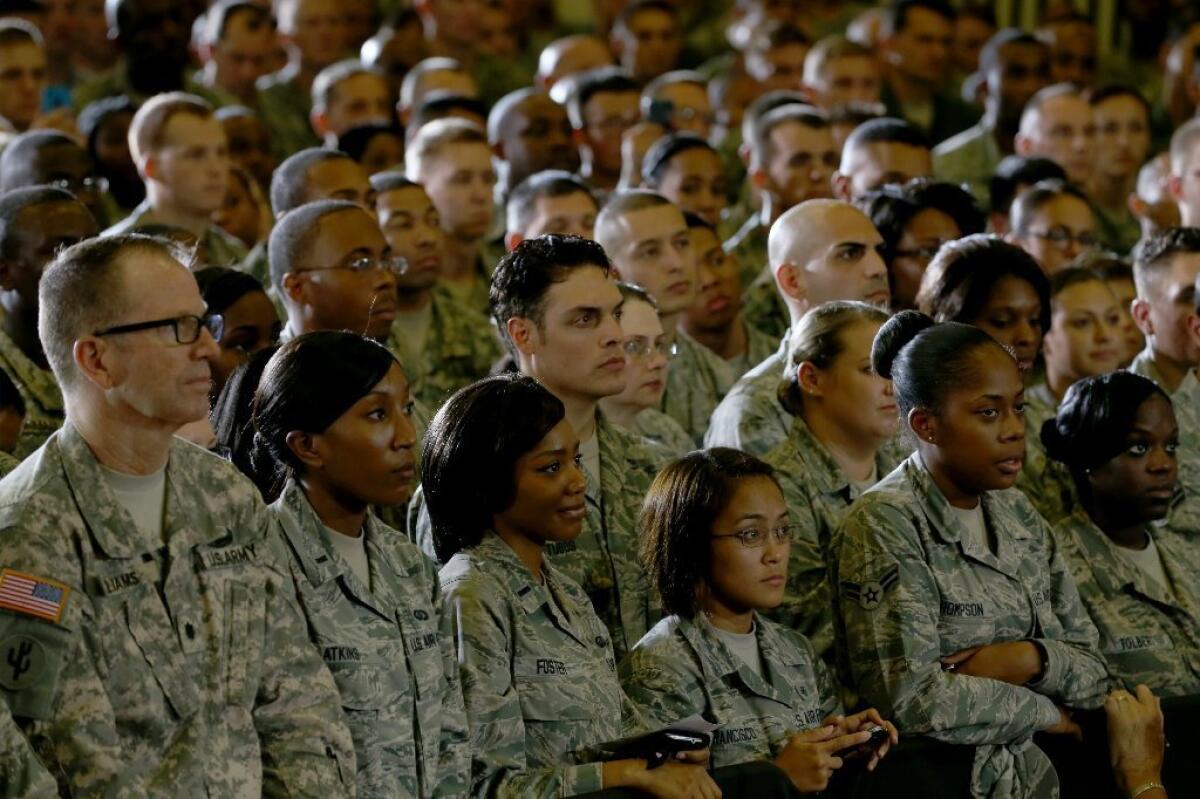Op-Ed: In honor of Veterans Day, let’s deal with the real costs of war

- Share via
Many Americans may not know that Veterans Day began as Armistice Day. At the 11th hour of the 11th day of the 11th month in 1918, the Allied nations and Germany agreed to an armistice, a temporary cessation of hostilities that began the process of ending World War I. In much of the world, at 11 a.m. local time, people still pause on Nov. 11 to observe a few moments of silence for the tens of millions killed and wounded in “the war to end all wars.”
Here in the United States, Congress renamed the holiday Veterans Day in 1954, with the idea of celebrating the sacrifice and heroism of all those who have served in uniform, not just those who fought in the First World War. But what’s required of us to do right by those who served?
For the last five years, we have been studying one specific group of these men and women in uniform to try to understand how being a nation at war these last dozen years, with an all-volunteer force stretched thin and fighting on two fronts, has affected our military personnel, their families and communities, and citizens of the countries where these campaigned are being waged. Our research has focused on Colorado Springs, Colo., a city housing some 70,000 active-duty military personnel and their family members and home to one of the largest populations of military retirees in the country.
One thing that has been striking is the number of wounded U.S. veterans we encountered. As we document in a new paper on the costs of our post-9/11 wars, the ratio of soldiers wounded in these recent conflicts to those who died is 9 to 1: in all other U.S. wars that ratio was a dramatically lower, 3 to 1. This new ratio is, in part, a tribute to improvements in battlefield medicine, something most Americans would applaud. But it does mean more wounded veterans with continuing — and expensive — needs.
Most visible among the wounded survivors who live in Colorado Springs and around the country are physical wounds — veterans living with blindness, deafness, burn scars, paralysis and multiple amputations. And as many as a third of all U.S. military personnel deployed to Iraq and Afghanistan return with invisible wounds: post-traumatic stress disorder, traumatic brain injury and major depression. Beyond physical and mental healthcare, returning soldiers often need financial and employment counseling, assistance applying for VA benefits or school tuition, or help reestablishing intimacy with family members and friends.
Yet soldiers and their advocates face numerous obstacles to getting needed support. At the beginning of the post-9/11 wars, the VA cared for a rapidly aging and shrinking population of World War II and Vietnam War veterans. The VA was unprepared for the numbers of wounded young veterans returning from Iraq and Afghanistan. Long wait lists left many veterans without needed care. The Army’s frequent use of less-than-honorable discharges for soldiers whose behavior officials deem problematic, but which might have resulted from PTSD or traumatic brain injury, disqualified many others from benefits and compensation.
The wars have also had a huge effect on the families of military personnel, whose burdens include maintaining homes, working to support the family, and coping with an absent spouse or parent. Children whose parents are deployed are more likely to suffer depression and show declines in their schoolwork. And after deployments, families struggle with how to bring the returning soldier back into family life that has gone on without them.
Today’s all-volunteer military force means that many Americans have little or no close contact with those who have fought in the post-9/11 wars. This makes it difficult for the vast majority of civilians to understand the experiences of returning soldiers and to engage in often-difficult conversations about the costs of war. But these conversations are essential if veterans are to reengage in civilian life and heal not only from the physical, but the moral and spiritual injuries of war.
On Nov. 11 this year, we urge all Americans to stop at 11 a.m. and observe a few moments of silence to honor all those who have borne the costs of war, at home and abroad.
Jean Scandlyn is a cultural anthropologist at the University of Colorado in Denver. Sarah Hautzinger is a professor of anthropology at Colorado College. They are both researchers for the Costs of War Project at Brown University.
Follow the Opinion section on Twitter @latimesopinion
More to Read
A cure for the common opinion
Get thought-provoking perspectives with our weekly newsletter.
You may occasionally receive promotional content from the Los Angeles Times.









